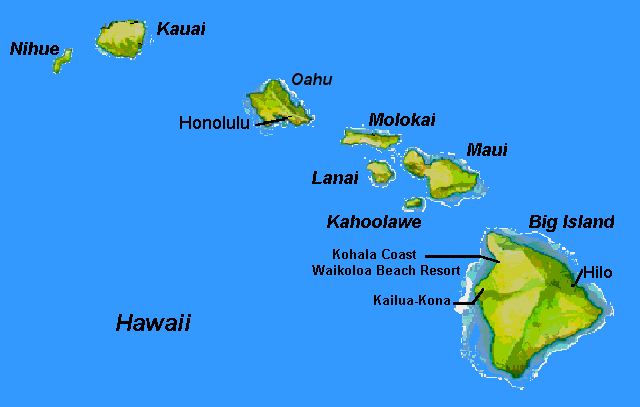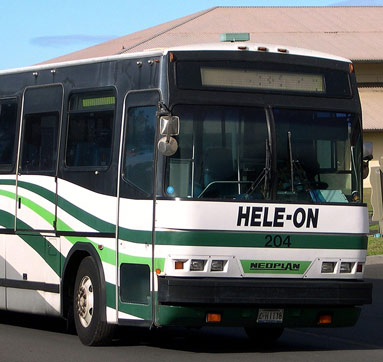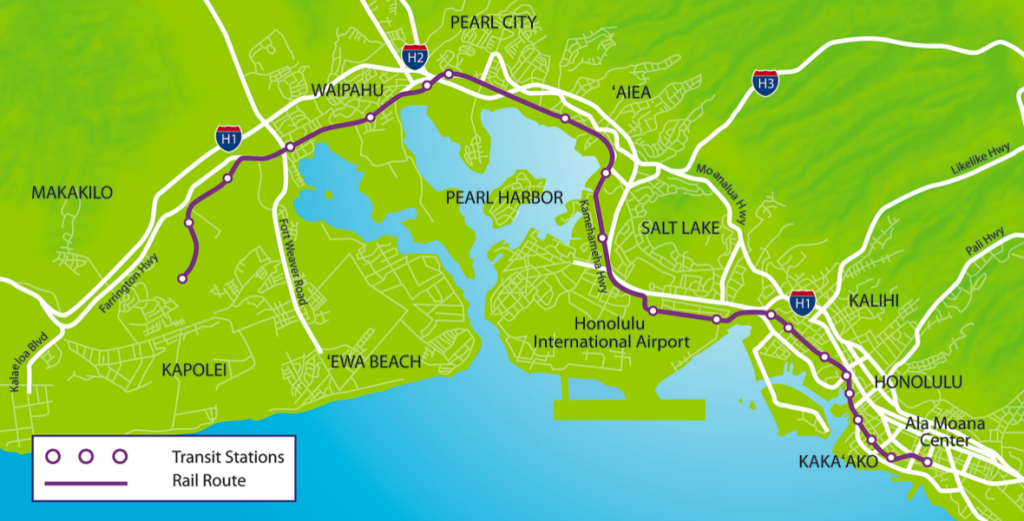
Honolulu once abounded with streetcars. Now, public transportation is in strong demand across Hawaii. Photo: Honolulu Star-Bulletin Archives
In this two-part report, Curbing Cars intern Matt Varcak lifts us out of the weather doldrums and takes us to Hawaii, a surprising hot spot for public transportation.
By Matthew Varcak
If you visit the Hawaiian Islands, you will likely enjoy beautiful weather, pristine bodies of water, ancient grounds, delicious food and happy people. I was lucky enough to be one of these people this past summer when I visited the Island of Hawaii (The Big Island).
What struck me the most — beyond that — was how affordable and extensive the mass transit was. Hawaii once had streetcars, and it soon will get a light rail system. Meanwhile, the main way people get around is on buses.
At roughly 4,000 square miles, the Island of Hawaii is the state’s largest island, but it is the second-most populous island behind Oahu. Its major cities are separated by long stretches of winding highways wrapping around Mauna Kea and Mauna Loa, two of Hawaii’s volcanoes, which stand at nearly 14,000 feet above sea level.
With a general fare only costing $1, it soon became clear that it would be much more affordable to ride the Hele-On Bus, Hawaii County’s Mass Transit system, rather than drive myself everywhere.
This meant even the two hour, nearly 100 mile trip from Kailua-Kona on the west side of the island to Hilo, located on the east side, only cost $1.
From 2005 to 2011, bus ridership was free for everyone. But in 2011, fares went into effect, and in July 2013, they rose again. General fares increased from $1 to $2. Students, seniors and those with disabilities who previously rode free of charge are now paying $1.
Fares went up because the bus system can’t cover increasing operating costs. It costs approximately $7 per passenger to operate the Hele-On Bus, according to Nancy Cook Lauer in the Hawaii Tribune-Herald.
The County of Hawaii Mass Transit Agency also offers a shared ride taxi program within the urbanized area of Hilo which provides door to door transportation for as little as $2.
Intrigued by The Island of Hawaii’s public transportation, I decided to look at the systems on the islands of Oahu and Maui to see if they compare. In this report, I’ll start with Oahu, and in my next story, I’ll look at Maui.
 At nearly 600 square miles, Oahu is Hawaii’s third-largest island. However, it is the most populous and possesses the largest mass transit system of any of the islands, namely because it hosts Hawaii’s biggest city, Honolulu.
At nearly 600 square miles, Oahu is Hawaii’s third-largest island. However, it is the most populous and possesses the largest mass transit system of any of the islands, namely because it hosts Hawaii’s biggest city, Honolulu.
Public transportation on Oahu dates to the late 1800’s when Honolulu Rapid Transit, a privately owned company, was established. It introduced street cars in the early 1900’s and began utilizing motor coaches beginning in 1925. Honolulu Rapid Transit continued to serve the island until 1941.
Today, Oahu residents and tourists rely on TheBus and TheHandi-Van, which are operated by Oahu Transit Services, a non-profit organization overseen by The City and County of Honolulu’s Department of Transportation Services.
An adult pass on TheBus costs $2.50 and entitles the rider to one free transfer valid for up to two hours. Monthly and annual passes are also available for $60 and $660, respectively. TheHandi-Van is a service for those with disabilities who are unable to use the TheBus. Fares are $1 on TheHandi-Van.
TheBus provided 74.5 million passenger boardings for the fiscal year 2013 or an average of 236,000 boardings each weekday. TheHandi-Van served an additional 3,400 riders daily during the week, adding up to 1 million boardings for the fiscal year 2013.
These are predominantly locals, although many tourists out of Waikiki (located on the southeastern portion of Oahu) use mass transit according to Michael Formby, director of the City and County of Honolulu Department of Transportation Services.
The system uses 526 buses (approximately 15 percent of which are hybrids) and 160 Handi-Vans. These vehicles expend nearly $24 million in fuel annually. TheBus has 101 fixed routes, more than 4,000 stops, and travels more than 22 million miles annually.
In 2013, the average passenger trip length on TheBus was 4.3 miles, while those on TheHandi-Van rode for an average of 10.7 miles. Oahu Transit Services employs more than 1,800 people, and it generated over $55 million in revenue for the fiscal year 2013.
“There is always a demand for more public mass transit,” said Formby in an email. “However, the cost, as heavily subsidized as it is, restricts any municipality’s ability to expand services.”
The biggest transit news in Hawaii is coming in the next few years.
The City and County of Honolulu is currently constructing a fixed, elevated rail line from west Oahu to the Honolulu urban core. The rail line will stretch 20 miles, include 21 stations, and is predicted to remove 40,000 vehicles from the streets when it becomes operational in 2019, according to the Honolulu Rapid Transit’s website.
Each two-car train can carry more than 400 passengers – the equivalent of more than five buses. Those light rail trains will definitely change the perception of how people in Hawaii get around. Take a look at this video about the new light rail system.
Next: a look at transportation on Maui


